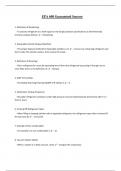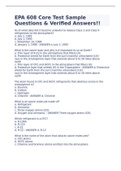Hvacr unit 14 - Study guides, Class notes & Summaries
Looking for the best study guides, study notes and summaries about Hvacr unit 14? On this page you'll find 13 study documents about Hvacr unit 14.
Page 2 out of 13 results
Sort by

-
EPA 608 Guaranteed Success
- Exam (elaborations) • 9 pages • 2024
-
Available in package deal
-
- $10.62
- + learn more
EPA 608 Guaranteed Success 1. Definition of Reclaiming: - To process refrigerant to a level equal to new (virgin) product specifications as determined by chemical analysis defines: ️ Reclaiming. 2. Disposable Cylinder Disposal Method: - The proper disposal method for disposable cylinders is to ️ recover any remaining refrigerant and then render the cylinder useless, then recycle the metal. 3. Definition of Recycling: - Clean refrigerant for reuse by separating the oil from the refr...

-
Fundamentals of HVACR Second Edition | Answers to End of Unit Questions | Latest exam Questions with Correct Answers
- Exam (elaborations) • 280 pages • 2021
-
- $17.49
- + learn more
UNIT 1 REVIEW QUESTIONS ANSWER KEY 1-1) List some of the different ways that homes and buildings may be heated. Wood, gas, oil, electric, solar, heat pumps, and geothermal heating systems are used. 1-2) What were some of the primary heating fuels that early civilizations used? Wood, peat, and coal remained the primary heating fuels for centuries. 1-3) When is it believed that ice was first artificially made for food storage? First evidence of man making ice appeared more than 3,000 years ...

-
EPA 608 Core Test Sample Questions & Verified Answers!!
- Exam (elaborations) • 53 pages • 2023
-
- $13.99
- + learn more
As of what date did it become unlawful to release Class 1 and Class II refrigerants to the atmosphere? a. July 1, 1992 b. July 1, 1993 c. November 14, 1994 d. January 1, 1996 - ANSWER a. July 1, 1992 What is the ozone layer and why is it important to us on Earth? a. Thin layer of R-22 in the atmosphere that filters UV. b. Protective shield for Earth from the sun's harmful ultraviolent (UV) rays in the stratosphere layer that extends about 6 to 30 miles above earth c. Thin layer of ...

That summary you just bought made someone very happy. Also get paid weekly? Sell your study resources on Stuvia! Discover all about earning on Stuvia


